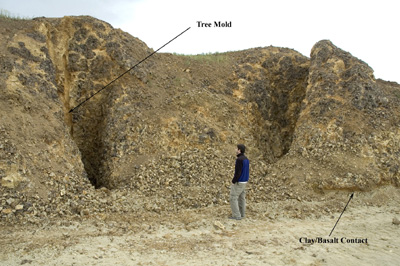Introduction
Fossil wood has been known from various localities in the Miocene Columbia River Basalt Group for many years. Recently, a new locality near Yakima, Washington was discovered. This locality is on private land and has been excavated by the landowner over a period of several years. The locality consists of a fossil wood-bearing basalt flow up to seven meters thick underlain by the Vantage interbed. Geochemical analysis of the basalt places the deposit within the Ginkgo Flow, Frenchman Springs Member of the Wanapum Basalt Formation, with an approximate age of 15.4 million years. The presence of basalt pillows and palagonite in the flow indicates that the basalt was deposited into a water environment.
 The wood is preserved as standing logs, directly entombed within the basalt. The logs are nearly all preserved in a vertical orientation and extend from the basalt/clay layer contact to the erosional surface at the top of the basalt flow. There is no indication that tree roots penetrate into the underlying clay layer. Diameter of the tree trunks ranges from 7.5 cm (3 inches) to over 45 cm (18 inches). On the whole, the wood is well preserved and an initial survey has been conducted to identify the wood type. The results of the survey show that the assemblage consists of approximately 69% hickory (Carya), 19% elm (Ulmus), plus minor amounts of maple (Acer) and sweetgum (Liquidambar). Honey locust (Gleditsia) may also be represented. A preliminary hypothesis is that the site represents an assemblage of tree species that colonized a dried lakebed. The trees were subsequently drowned when the lakebed refilled, and then were preserved by lava that inundated the lake.
The wood is preserved as standing logs, directly entombed within the basalt. The logs are nearly all preserved in a vertical orientation and extend from the basalt/clay layer contact to the erosional surface at the top of the basalt flow. There is no indication that tree roots penetrate into the underlying clay layer. Diameter of the tree trunks ranges from 7.5 cm (3 inches) to over 45 cm (18 inches). On the whole, the wood is well preserved and an initial survey has been conducted to identify the wood type. The results of the survey show that the assemblage consists of approximately 69% hickory (Carya), 19% elm (Ulmus), plus minor amounts of maple (Acer) and sweetgum (Liquidambar). Honey locust (Gleditsia) may also be represented. A preliminary hypothesis is that the site represents an assemblage of tree species that colonized a dried lakebed. The trees were subsequently drowned when the lakebed refilled, and then were preserved by lava that inundated the lake.
